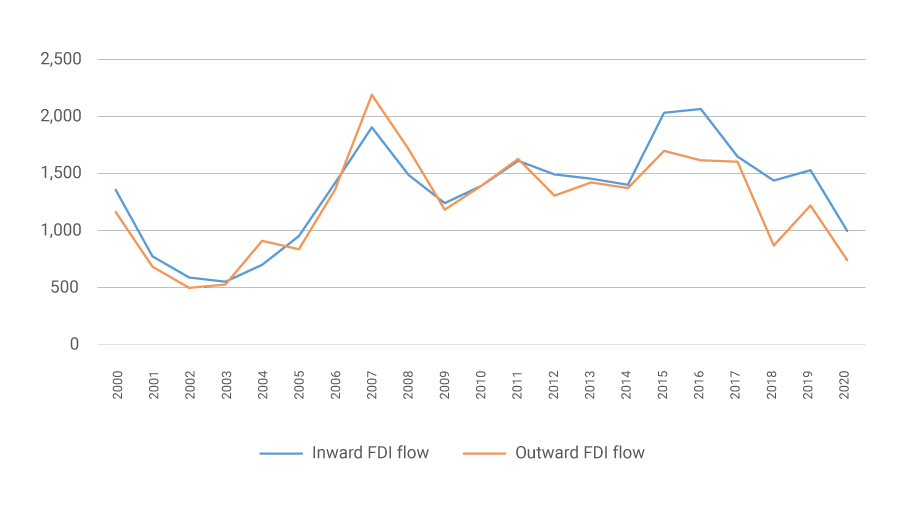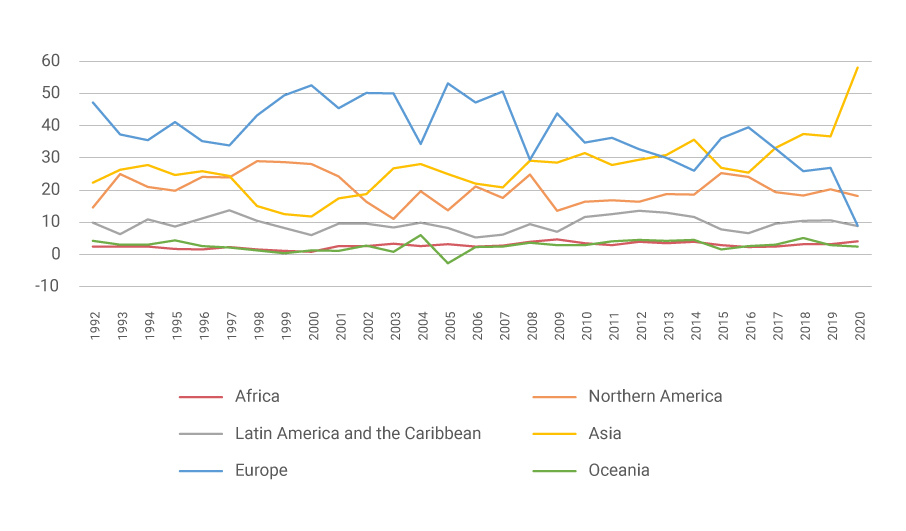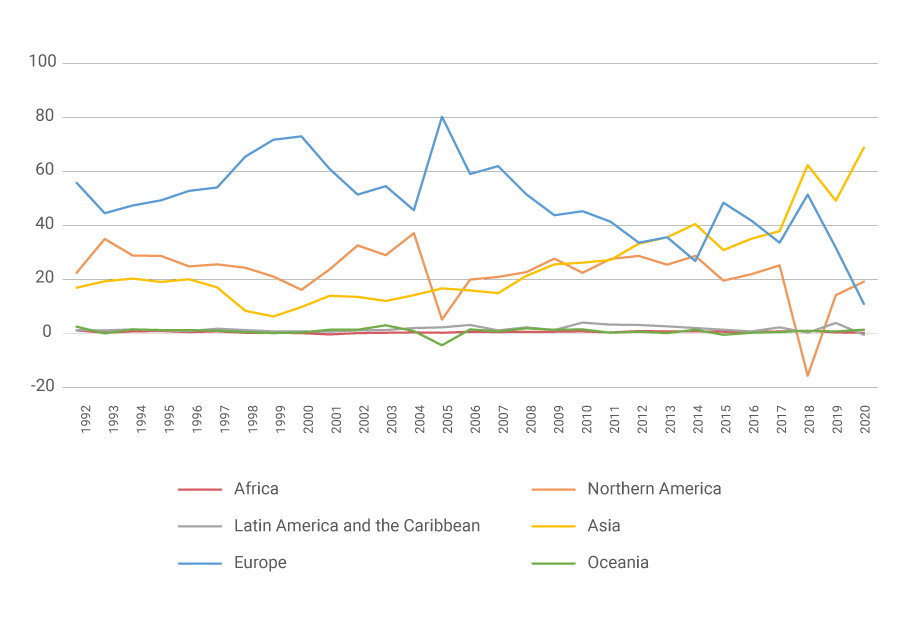
Dr. Areef Suleman is Director of Economic Research and Statistics at the Islamic Development Bank Institute.

Dr. Mustafa Yağcı is a Senior Economist at the Department of Economic Research and Statistics at the Islamic Development Bank Institute.
The world continues to be shackled by the Covid-19 pandemic after the sudden halt to economic activity and general mobility — with the early months being dubbed as “the Great Cessation”. This posed enormous risks to the trajectory of global economic development. Apart from international trade, private flows, which play a significant role in economic development in many countries, were at risk of substantial decline. Yet contrary to expectations, private flows — and foreign direct investment (FDI) in particular — to Asian economies exhibited strong resilience despite the rapid and sharp health and economic impact of Covid-19. More than half of the world’s FDI flows in 2020 went to Asia, evidence of a gravitational shift of the world’s economic center to the east.
Private flows (or private capital flows) are the total financial flows coming from private sector resources and private grants. Private sector resources are determined by changes in private and long‑term asset holdings by residents, while private grants emanate from non‑government organizations. Accordingly, private flows can be categorized as FDI, portfolio equity, remittances, and private sector borrowing.4
Global economic development is significantly associated with private flows between individual economies, which are thought to stimulate growth and development thanks to the benefits that ensue from an increased efficiency in the financial sector, the sharing of knowledge and technological competencies, and the unlocked trade opportunities, to name but a few.1 Trends in private flows between economies uncover insights on growth opportunities for regions receiving both substantial and sustained private flows across years.

Global FDIs are a critical component of private flows for supporting global development. Figure 1 illustrates the trends in global inward and outward FDI flows from 2000 to 2020. Decline in flows are observed during crisis years: first, between 2000 and 2002 due to the dot‑com bubble burst; second, between 2007 and 2009 due to the global financial crisis; and third, in 2020 due to the onset of the Covid-19 pandemic. Interestingly, global inward and outward FDI flows had already been declining even before the pandemic, beginning 2017.
Figure 1. Global inward and outward FDI flows

Note: Measured in USD billions
Source: UNCTAD; unctadstat.unctad.org/wds/TableViewer/tableView.aspx?ReportId=96740
To investigate the downward trend in FDI flows beginning 2017, Figures 2 and 3 respectively show the global distribution of inward and outward FDI flows as a share of the world total FDI flows across six major regions: Africa, Asia, Europe, Latin America and the Caribbean, Northern America, and Oceania. Trends vary across the six regions but the evolution of FDI flows as a share of world for two regions — Asia and Europe — stands out because of their apparent divergence. As seen in Figures 2 and 3, shares of inward and outward FDI flows to world total had been gradually increasing in Asia between 2007 and 2019. In contrast, over the same period, inward and outward FDI flows shares had been declining in Europe.
The rise in Asia’s share of global inward FDI flows, accompanied by the decline of Europe’s share (Figure 2), reflects the shift of investment from Europe to Asia. This is indicative of investors having higher growth expectations in Asia compared to the rest of the world during the periods shown. More interestingly, despite the pandemic in 2020, Asia’s share of global inward FDI flows rose steeply in 2020, with Asia receiving more than half of investment flows in the world.
The rapid growth in inward FDI flows to Asia was largely due to flows to China (driven by investments in technology-related industries, e-commerce, and R&D), India (driven by investments in ICTs and construction), and the UAE (driven by acquisitions in the energy sector).6 The resilience of FDI flows to Asia amid crises such as the Covid-19 pandemic has potential positive synergies on economic growth when juxtaposed with resilient intraregional value chains. If these trends continue, we can expect a gradual gravitational shift of the world’s economic center to Asia. Favorable regional trade agreements such as the Regional Comprehensive Economic Partnership (RCEP) agreement, which is the Association of Southeast Asian Nations (ASEAN) region’s biggest trade agreement, is anticipated to support this.
Figure 2. Inward FDI flows as a percentage of the world total

Source: UNCTAD; unctadstat.unctad.org/wds/TableViewer/tableView.aspx?ReportId=96740
Figure 3. Outward FDI flows as a percentage of the world total

Source: UNCTAD; unctadstat.unctad.org/wds/TableViewer/tableView.aspx?ReportId=96740
Increased FDI flows to Asia are expected to boost growth in the post-pandemic world. However, the strength and magnitude of such growth will depend on where the funds are channeled and how they are used.1 Recent literature suggests that investment in the digital economy and Industry 4.0 technologies (by building better communication and digital infrastructure) is key to faster economic recovery. 2, 3 However, for inclusive and sustainable economic growth to happen, investments must additionally be channeled to reskilling and retraining the labor force to counter potential job losses due to automation.
Recent geopolitical conflicts highlight the post-pandemic world as essentially being new territory for all economies. As such, careful investment decisions must be made. Nonetheless, the resilience of FDI flows to Asia provides some confidence in positive economic growth prospects for the region in the near term.
References:
1 Agbloyor, E., Yawson, A., Opperman, P. (2021). ‘Private Capital Inflows — the Answer to Africa’s Financing Shortfall?’ USB Management Review, January 2021. usb.ac.za/usb_insights/private-capital-flows-and-economic-growth/ accessed 15 March 2022.
2 Asian Development Bank (ADB). (2022). ‘ASEAN’s Share in Global FDI Growing Despite COVID-19’. Southeast Asia Development Solutions (SEADS), 13 September 2021. seads.adb.org/news/aseans-share-global-fdi-growing-despite-covid-19 accessed 15 March 2022.
3 Brunei Darussalam–Indonesia–Malaysia–Philippines East ASEAN Growth Area. (2021). ‘A 4IR-Ready Workforce May Be the Key to Faster Business Recovery’. BIMP-EAGA, 13 April 2021. bimp-eaga.asia/article/4ir-ready-workforce-may-be-key-faster-business-recovery accessed 15 March 2022.
4 Organisation for Economic Co-operation and Development (OECD). (2022). ‘Private Flows’. (indicator). OECDiLibrary. doi.org/10.1787/4d31a9d6-en accessed 2 March 2022.
5 United Nations Conference on Trade and Development (UNCTAD). (2022). ‘Investment Trends Monitor’. Issue 40, January 2022. unctad.org/system/files/official-document/diaeiainf2021d3_en.pdf accessed 15 March 2022.
6 United Nations Conference on Trade and Development (UNCTAD). (2021). ‘Investment Flows to Developing Asia Defy COVID-19, Grow by 4%’. UNCTAD, 21 June 2021. unctad.org/news/investment-flows-developing-asia-defy-covid-19-grow-4 accessed 15 March 2022.
7 United Nations Conference on Trade and Development (UNCTAD). (2021). ‘SDG Investment Trends Monitor’. Issue 3, April 2021. unctad.org/system/files/official-document/diaemisc2021d3_en_2.pdf accessed 15 March 2022.
Henley & Partners assists international clients in obtaining residence and citizenship under the respective programs. Contact us to arrange an initial private consultation.

Have one of our qualified advisors contact you today.
We use cookies to give you the best possible experience. Click 'Accept all' to proceed as specified, or click 'Allow selection' to choose the types of cookies you will accept. For more information, please visit our Cookie Policy.